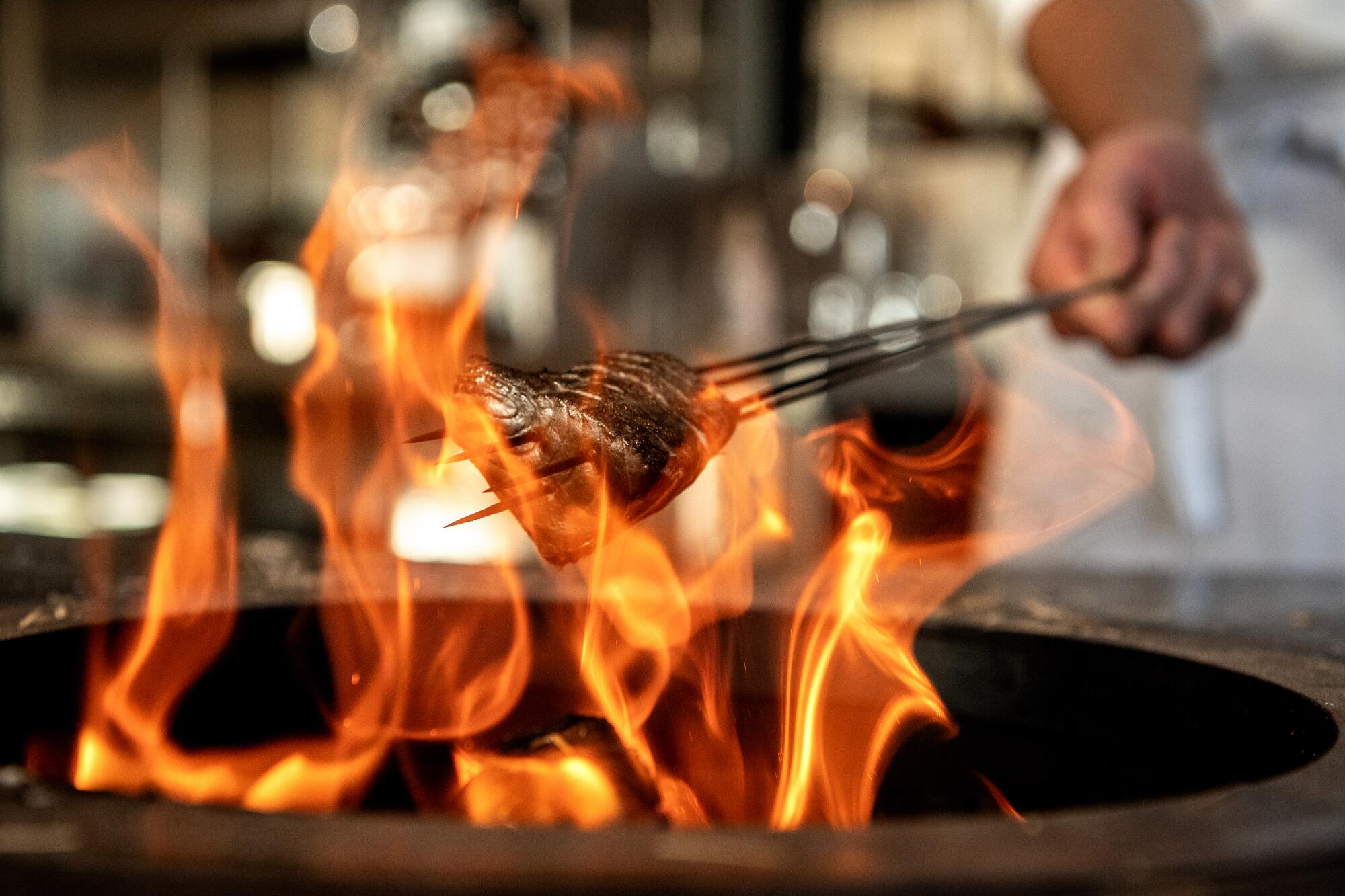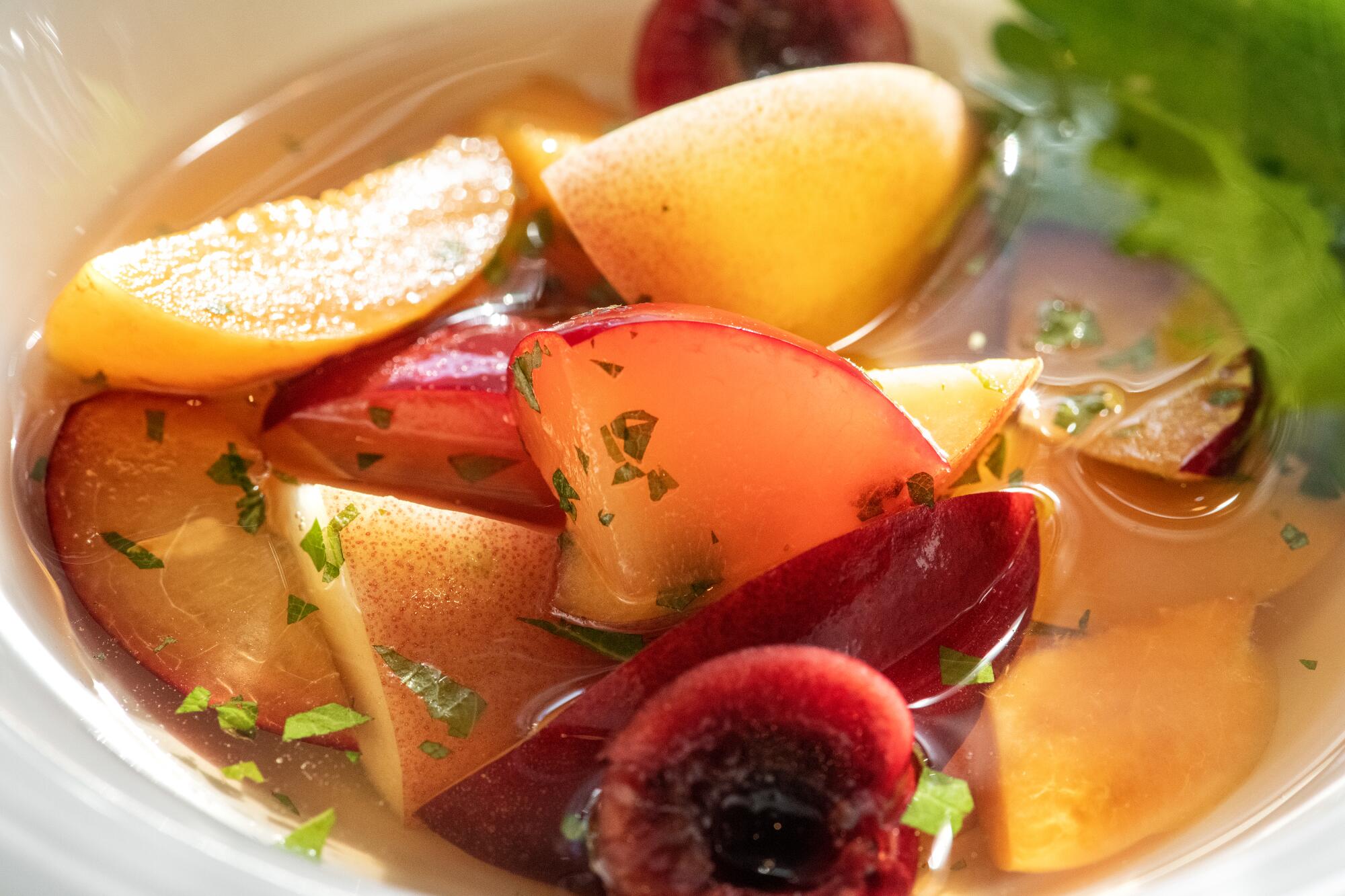
Calling it a ‘Japanese seafood restaurant’ doesn’t capture the eclectic joys at the Arts District’s next great dining destination.
The long, narrow, single-story building at 2001 E. 7th St., its catty-cornered entrance facing the intersection of Mateo Street, debuted in 1924. Fortresslike, with imposing concrete brick and Spanish Baroque gilding, the structure once housed a Bank of America branch. Eventually it sat largely unused and unchanged for decades.
In early spring, as a long-delayed sign of life, the building’s white façade received a new door. Made of pale cypress, it pops against the ornamental inlay arching over the entrance, a part of which has been painted black to stress the light-dark contrast. The door feels weighty, almost formidable, but with an oddly welcoming design twist: It was installed at a purposeful slant to appear as though it might already be propped open.
“You’re at the right place,” the angle seems to convey. “Grab the handle and come inside.”

This is how you walk into 3-month-old Yess Restaurant, which serves some of the most quietly ambitious cooking to emerge in Los Angeles this year. The complex beauty of the space complements the kinetic, largely Japanese menu, though the soaring scale of both can take a minute to absorb.
Scan the room’s periphery for the stark, familiar details of Arts District remodels: exposed rafters and piping, concrete everywhere, craggy red brick freed from layers of plaster, glass-block windows that reach nearly floor to ceiling. The proper dining area goes softer on the senses. At round tables, fashioned from fine-grained keyaki, customers pass plates of exactingly sliced sashimi, grilled fish perfumed with almond-wood smoke, salads of ripe fruit, and vegetable dishes doubling as color wheels.
Chef Peter Lai, recruited from Embassy Kitchen, blends notions of tradition, modernism and personal creativity in an up-and-down menu that expands the reach of Cantonese cuisine in L.A.
Diners solo or in pairs likely will land at the sprawling, 42-seat cypress bar. It’s front row to the show: an open kitchen that gleams like a starship.
I can make out its various features and gadgets — a wood-fire range called a kamado fitted with a smoker and massive steel steaming basket, the charcoal-fueled robata, a manual ice shaver stationed near the back — but then my eyes always end up refocusing to take in the overall scene. Dramatic half walls float above the stoves to delineate the space. Their blankness resembles a gallery between exhibits, but they aren’t entirely bare. Owner and designer Kino Kaetsu covered them with enormous, discreet art works entitled “Salt Painting” by artist Moeko Maeda. As night falls and blueish lights glint off all the metal and gizmos below them, the sci-fi imagery becomes even more vivid: The kitchen doesn’t look so much constructed but symbiotic, as if a still-operational spacecraft has been embedded so long in a mountain that it’s become part of the terrain.


The leader of the command center is easy to single out. Junya Yamasaki stands at a midpoint between the other focused chefs, calm, head usually down and exceptionally intent.
He channels these qualities into an early, daily-changing signature he calls “monk’s chirashi-sushi.”
From 20-course omakase tasting menus to snug sushi bars, here’s where to find the best and freshest sushi in Los Angeles.
In late July a black bowl held red, green and orange cherry tomatoes, each with similarly bursting textures; fresh peaches cut in thick triangles; bright, blanched green beans cleaved on the diagonal; crinkled slips of pickled eggplant; two kinds of shiso for a surprise burst of sharp flavors; and toasted almonds for occasional crunch. The density of ingredients hides a bed of gently astringent rice underneath. It’s the foil by which these tastes of summer are expressed individually and collectively.
If a bowl of rice and farmers market loot sounds like dull pabulum, or punishment, well — this is summer in California, so it tastes like pure goodness to me, particularly when each element has been considered with such care.

Yamasaki encapsulates his cooking as “progressive Japanese.” I wish the phrasing wasn’t so vague but concede his style is hard to summarize. “Japanese seafood restaurant” doesn’t quite describe its breadth, though Yamasaki is a devoted diver and fisher. In the several years leading up to Yess, he made frequent outings on the water to acquaint himself with Southern California’s sustainable marine life.
On the menu they translate to dishes like whole rockfish stuffed with fennel, lemon and other aromatics, cooked in parchment just until opaque and splashed with gentle citrus ponzu. Or a few small hunks of grilled black cod, shaved corn and mochi rice steamed in fig leaves until they’ve absorbed its distinct herbal-nutty earthiness.
Dinner might begin with a collage of peaches, nectarines, apricots, pluots and cherries, each at their sunniest prime, in a cooling pool of dashi. Or agebitashi, a Japanese method of flash-frying vegetables before braising them in dashi, so that in this case peppers, slender eggplant and extra-long string beans are yielding with also a wrinkly sort of crispness. Soy sauce plus grated daikon and ginger bring in levels and depths of flavor.


Somewhere between them you might order whole tiny fried horse mackerel, whose bones crackle easily between the teeth, ignited with a reimagining of salsa borracha that includes chipotles, anchos, habaneros roasted and then doused with sake. The result is subtler than using beer or tequila, but Yamasaki uses a sake with notes of citrus and pickled plum that works.
He tends to lean into understated combinations even in his meatier efforts: sliced pork steak paired with apricot miso, a condiment as fresh and restrained as it sounds, or grilled beef steak with a salad of grapes, walnuts and a riff on soy-based sukiyaki sauce deglaced with wine and chipotle.
It’s the walk-the-walk approach to seasonality and talent for direct flavors that brought Yamasaki acclaim early in his career in London. For five years he ran Koya, an udon bar that attracted regulars devoted equally to the excellent noodles and to the small plates that revealed his penchants for produce and nuance. He left the restaurant in 2015 for personal pursuits, including studying shojin ryori — the Buddhist or temple cuisine that has deeply influenced many aspects of Japanese food and drink culture — before moving to Los Angeles.
Giles Clark followed Yamasaki from London for Yess. While weathering pandemic-related construction delays on the restaurant, the two of them ran the traffic-cone-orange food truck Yess Aquatic, which served sashimi and a very satisfying fish katsu sandwich. He now mans the starship as sous chef.


Even with Yamasaki’s international reputation, and early local fans earned via the truck, I’ve noticed relatively light crowds in Yess during its first few months. Is it the building? One friend who lives downtown remarked that the restaurant has little signage or, lacking picture windows, scant street presence.
Is it the vibe? I’m sold, but if I veer to snark I can imagine the jibes: The thoughtful, warm crew of servers wear white robe-type outfits that look like something out of a spa, or maybe costumes in a restaurant-themed Wes Anderson movie. And Yamasaki’s use of seasonings in the restaurant’s first weeks was arguably too restrained. He needed to find his own footing and to sync with the Angeleno palate in real time, and I’d argue he course-corrected quickly.
What does modern Korean cooking taste like in Los Angeles? A chef with a tiny restaurant and concise tasting menu offers a compelling answer.
There is also the cost. Prices for more substantial dishes run from $28 to $55, and large-format platters like the whole fish skirt $80. Those fall in the same range as many of the always-packed finer-dining options across Los Angeles, but this is a semi-hidden unknown on a solitary corner during a summer when vital factions of the city’s entertainment industry are on monthslong strike.
Then again: In July Yamasaki announced a limited special $180 tasting menu highlighting locally caught tuna. Among its pleasures was hay-smoked tataki served over a mound of herbed daikon and papery sliced lime; marinated and fried bloodline (the name for darker tuna meat) with mineral, steaky savor; and a sublime soup of tuna tsukune with winter melon. Putting the ice shaver to good use, the team had concurrently rolled out a refreshing, of-the-moment new variation on kakigori — cantaloupe with ginger syrup.

The restaurant had never been so crowded. Every staffer in Yess looked as if they’d found themselves in a film being played at double-speed, but the experience came off with the same serene finesse.
Finding its niche may take more experimentation, but I trust that this gifted team, and its otherworldly space, has a lasting place in L.A.’s dining landscape.
Yess Restaurant
2001 E. 7th St., Los Angeles, instagram.com/yess.restaurant
Prices: Menu changes daily. Most small plates $18-$26, larger plates $28-$55, large-format dishes $70 and up, kakigori for dessert $20.
Details: 5:30-9 p.m. Wednesday-Sunday. Wine, sake and shochu. Lot and street parking.
Recommended dishes: monk’s chirashi-sushi, savory stone fruit salad, whole fish papillote with ponzu, kakigori with seasonal fruit. Smart, succinct selection of sake and wine; try the passionfruit, sweet potato shochu and tonic cocktail, or the hibiscus lemonade.
More to Read
Eat your way across L.A.
Get our weekly Tasting Notes newsletter for reviews, news and more.
You may occasionally receive promotional content from the Los Angeles Times.









